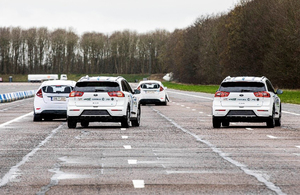A UK government-backed consortium has achieved a ‘world first’ by demonstrating a collision-avoidance system in which 2 vehicles co-operate by radio link to steer around a stationary car without human assistance.
The successful live demo at Bruntingthorpe Proving Ground in Leicestershire is a significant milestone in developing a driver aid to avoid multi-vehicle collisions, particularly motorway pile-ups.
It was the climax of a 32-month project called MuCCA (Multi-Car Collision Avoidance), led by Applus IDIADA and involving 5 other automotive industry, technology and research partners. This £4.6 million project was jointly funded by the Centre for Connected and Autonomous Vehicles (CCAV) and delivered through Innovate UK.
There were 1,870 road deaths in the UK to June 2019 and human error is a factor in 95% of accidents.
Acting autonomously, vehicles equipped with MuCCA technology figure out between them what to do when confronted with an obstacle or a likely collision. If an accident is unavoidable, the MuCCA system will intervene to minimise injuries and damage. In normal traffic, the technology could help to reduce the bunching and congestion on motorways which is costly to the UK economy.
MuCCA incorporates 3 key elements:
- sensing of the immediate environment around the vehicle
- automatic steering as well as automatic braking
- live vehicle-to-vehicle radio messaging, communicating 50 times a second
The autonomous vehicles cooperate in real-time – something humans cannot do – and can manoeuvre to give another car the space to avoid an obstacle. With sophisticated machine learning algorithms developed at Cranfield University, MuCCA can even predict how non-autonomous vehicles with human drivers are likely to react. The next stage of development will focus on refining the control systems and extending simulation testing to more tricky scenarios and higher speeds.







